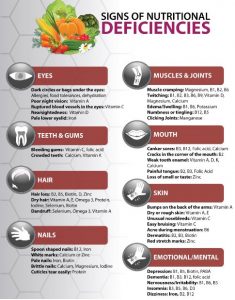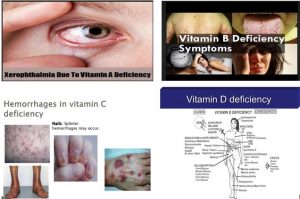
Basic concept of nutrients:
- Nutrients are the organic substances congregated inside the food and used by the body for the maintenance of life and growth.
- We get nutrients needed for our body from the food we consume i.e. rich in nutrients, for the proper growth and functioning of body. In absence of nutritious food, various health problems and deficiency diseases collides in our bodies.
- Some of the common results occurred due to nutritional deficiencies are:
- Marasmus
- Kwashiorkor
- Goiter
- Anemia
- Night blindness
- Scurvy
- Rickets etc.
Types of different macro-nutrients, their deficiency disorders, symptoms, prevention and mitigating measures:
| Macro nutrients | Major deficiency disorder | Symptoms | Prevention | Mitigation measures |
| Carbohydrates | Diabetic ketoacidosis, hyperosmolar coma, hypoglycemia | -Energy loss and fatigue
-Weight loss, -Constipation |
-Balanced diet.
-Educate children on the importance of carbohydrates.
|
-Maintain a healthy body weight
-Awareness on the importance of balanced diet |
| Fats | Heart disease, stroke, kidney problems, pediatric obesity, childhood obesity, metabolic syndrome | -Small bumps on back of upper arms.
-Variation of skin. -Mixed oily and dry skin
|
-Regular exercise
-Low intake of oily foods -Educate children on the effects of junk foods. |
-Maintain a healthy body weight
-Awareness on the importance of fats and its adequate intake. |
| Proteins | Kwashiorkor, marasmus and hypoalbuminemia | -Loss of muscle mass.
-Increased risk of bone fractures. -Risk of infections. -Inhibit proper body growth in children
|
-Establishment of nutrition centers, therapeutic feeding centers. | -Establishment of PEM control programme
-Counselling centers for effective breastfeeding and complementary feeding, Promotion of Vitamin A campaigns
|
| Water | Dehydration, kidney failure | -Dry mouth
-Eye, shortness of breath, heart palpitation, dizziness and confusion |
-Continue a regular diet
-Provide extra fluids to the child if he/she is vomiting,
|
-Provision of safe drinking water; discourage water pollution and drainage system, awareness campaign on importance of watery fluids in the body with its consequences. |
| Micro-nutrients | Major deficiency disorder | Symptoms | Prevention | Mitigation measures |
| Iodine | Goiter, hypothyroidism, increased risk of stillbirth & birth defects | -Fatigue and Weakness
-Hair loss -Dry, Flaky Skin, -Feeling Colder than Usual -Changes in Heart Rate, -Trouble in Learning and Remembering. -Unexpected weight gain |
-Optimal intake of dietary iodine during pregnancy
-Lactation -Strict monitoring in the quality of iodized salt |
Assessment techniques-
-Goiter rates -Urinary iodine -Measurements of TSH -Iodine in food and water |
| Iron | Iron deficiency, anemia, increased maternal and infant mortality, low birth weight | -Extreme fatigue
-Pale skin -Inflammation or soreness of tongue -Brittle nails -Chest pain |
-Diet high in iron rich foods
-Supplementation of folic acid to child bearing aged women, ― Treatment of iron deficiency for all ages
|
Assessment techniques
-Screening for anemia among women childbearing age -Emphasize on sound iron nutrition for infants |
| Zinc | Poor pregnancy outcome, impaired growth | -Altered/loss of taste and smell.
-Anorexia -Diarrhea. -Excessive hair loss.
|
-Increase intake of zinc-containing foods like: baked beans, yogurt.
-Maximum zinc intake can cause symptoms that range from nausea and vomiting to impaired immune system functioning. For this reason, adults older than age 19 should not take more than 40 mg of zinc a day.
|
-Improving the processes by which Zn moves from the soil into the plant and eventually into the edible part of the grain that has the potential to mitigate problems associated with Zn deficiency in crops and humans.
-Awareness of the importance of animal-source foods in the diet for infants and young children |
| Vitamin A | Night blindness, xerophthalmia, | -Slowing growth and development in fetus, raise risk of anemia in pregnant women,
-Vision disturbances, joint pain. |
-Behavior modification where high intake of vitamin A rich foods
-Dietary modification: Home and community provisioning to increase availability of vitamin A rich foods. |
-Gardening Project to Increase Production and Consumption of Vitamin A-Rich Foods
-Small animal husbandry and fish Production to increase household and community availability of preformed Vitamin A Sources -Multi-Mix Complementary and Weaning Foods
|
| Folate (Vitamin B6) | Megaloblastic anemia, neural tube and other birth defects, heart disease, stroke | -Mood Changes
-Weakened immune function. – Tiredness and low energy -Tingling and Pain in Hands and Feet -Seizures -Sore, Glossy Tongue.
|
-Optimum amount intake of vitamin B6 rich foods.
-Use of vitamin b6 drugs in correct way. |
-Increase Production and Consumption of Vitamin B6-Rich Foods |
| Cobolamine (Vitamin B12) | Megaloblastic anemia | -Constipation, diarrhea
-Nerve problems like numbness or tingling, -Vision loss -Mental problems like depression, or behavioral changes
|
-Optimum amount intake of vitamin B12 rich foods.
-RDA vitamin B12 is 2.4 mcg for men and women age 19 and over. Pregnant women have slightly higher requirements: 2.6 and 2.8 mcg per day, respectively. |
-Since the body is able to store enough vitamin B12 to meet its needs for several months, vitamin B12 deficiency is extremely rare among healthy people whose daily diet includes foods that are naturally rich in or enriched with vitamin B12. |
| Thiamine (Vitamin B1) | Beriberi Wernicke and Korsakov syndromes | -Fatigue.
-Irritability -Reduced Reflexes. -Tingling Sensation in Arms and Legs. -Muscle Weakness. -Blurry Vision. -Nausea |
-Improved nutrition, removal alcohol consumption
-Consumption of animal products. |
-Increase production and consumption of vitamin B1-rich foods |
| Riboflavin (Vitamin B2) | Nonspecific – fatigue, eye changes, dermatitis, brain dysfunction, impaired iron absorption | -Dryness and cracking of the skin
-Red, dry tongue called magenta tongue. -Skin rash. -Anemia. -Weakness and fatigue. -Vision problems |
-Recommended Dietary Allowance (RDA) is 1.3 milligrams daily for men and 1.1 mg for women. A higher dose of 3 mg per day can help to prevent cataracts. | -Increase production and consumption of vitamin B2-rich foods |
| Niacin (Vitamins B3) | Pellagra | -Thick, scaly-pigmented rash on skin when exposed to sunlight.
-Swollen mouth and bright red tongue. |
-RDA of niacin for adult males is 16 milligrams (mg) a day and for adult women who aren’t pregnant, 14 mg a day | Increase production and consumption of vitamin B3-rich foods |
| Vitamin B6 | Dermatitis, neurological disorders, convulsions | -Skin Rashes.
-Mood Changes. -Weakened immune function. -Tiredness and Low Energy. -Seizures.
|
-Optimum amount intake of vitamin B6 rich foods.
-Use of vitamin b6 drugs in correct way. |
-Increase production and consumption of vitamin B6-rich foods |
| Vitamin C | Scurvy (fatigue, hemorrhages) | -Rough, Bumpy Skin.
-Corkscrew-Shaped Body Hair -Bright Red Hair Follicles -Spoon-Shaped Fingernails with Red Spots or Lines -Dry, Damaged Skin -Slowly Healing Wounds
|
The United States (U.S.) Office of Dietary Supplements (ODS) advice the following intake of vitamin C:
-Up to 6 months: 40 mg, as normally supplied though breastfeeding -During pregnancy, women should consume 85 mg of vitamin C, rising to 120 mg while breastfeeding. -Smokers need 35 mg more than nonsmokers do every day.
|
-Promotion of health research projects on vitamin C deficiency and its associated factors.
-Increase production and adequate consumption of vitamin C-rich foods |
| Vitamin D | Rickets, osteomalacia, osteoporosis, colorectal cancer | -Bone and Back Pain
-Depression -Impaired Wound Healing -Bone Loss -Hair Loss -Muscle Pain
|
-Increase vitamin D supplement
-Eat foods rich in vitamin D -Increase exposure to natural sunlight |
-Maintain a healthy body weight
-Monitoring and treating medical conditions: -Using vitamin D supplements |
| Calcium | Decreased bone mineralization, rickets, osteoporosis | -Tingling Fingers-Muscle cramps-Lethargy-Poor appetite | -Reducing intake of caffeine-Inclusion of dairy products in daily diet-Educate children on the importance of dairy products. | -Maintain a healthy body weight
-Monitoring and treating medical conditions |
Types of different micro-nutrients, their deficiency disorders, symptoms, prevention and mitigating measures:
References and For More Information:
- https://www.ennonline.net/fex/5/basics
- https://www.ncbi.nlm.nih.gov/pubmed/12346313
- https://www.medicalnewstoday.com/articles/320891.php
- https://www.ewg.org/research/how-much-is-too-much/harmful-effects-excess-vitamins-and-minerals
- https://www.sciencedirect.com/topics/medicine-and-dentistry/macronutrient
- https://www.researchgate.net/publication/265786793_Effects_of_macronutrient_deficiencies_on_the_growth_and_vigour_of_khaya_ivorensis_seedlings
- https://www.msdmanuals.com/home/disorders-of-nutrition/overview-of-nutrition/carbohydrates,-proteins,-and-fats
- https://emedicine.medscape.com/article/1104623-overview
- https://www.livestrong.com/article/269901-a-list-of-protein-deficiency-diseases/
- https://www.nap.edu/read/5962/chapter/7#174
- http://www.cjhr.org/article.asp?issn=2348-3334;year=2014;volume=1;issue=2;spage=119;epage=122;aulast=Lal
- https://www.cdc.gov/mmwr/preview/mmwrhtml/00051880.htm
- https://academic.oup.com/jn/article/137/4/1101/4664657
- https://link.springer.com/article/10.1007/s11104-012-1315-3
- https://www.healthline.com/nutrition/vitamin-a#toxicity-and-dosage
- https://www.ncbi.nlm.nih.gov/books/NBK230106/
- https://www.webmd.com/diet/vitamin-b12-deficiency-symptoms-causes#2-8
- https://ods.od.nih.gov/factsheets/VitaminB6-HealthProfessional/
- https://emedicine.medscape.com/article/1104623-treatment
- https://extranet.who.int/nutrition/gina/en/node/23140
- Ravindran RD, Vashist P, Gupta SK, Young IS, Maraini G, Camparini M, et al. Prevalence and risk factors for vitamin C deficiency in north and south India: a two centre population based study in people aged 60 years and over. PloS one. 2011;6(12):e28588.
- Chambial S, Dwivedi S, Shukla KK, John PJ, Sharma P. Vitamin C in disease prevention and cure: an overview. Indian journal of clinical biochemistry : IJCB. 2013;28(4):314-28.
- Latham MC. Protein-energy malnutrition–its epidemiology and control. Journal of environmental pathology, toxicology and oncology : official organ of the International Society for Environmental Toxicology and Cancer. 1990;10(4-5):168-80.
- Jolliffe N. The Diagnosis, Treatment, and Prevention of Vitamin B1 Deficiency. Bulletin of the New York Academy of Medicine. 1939;15(7):469-78.

